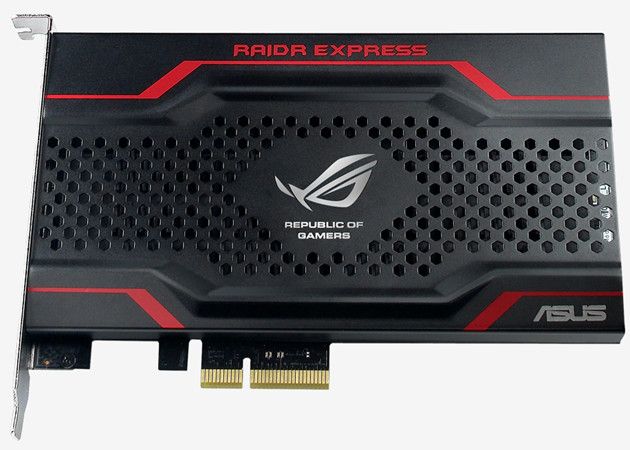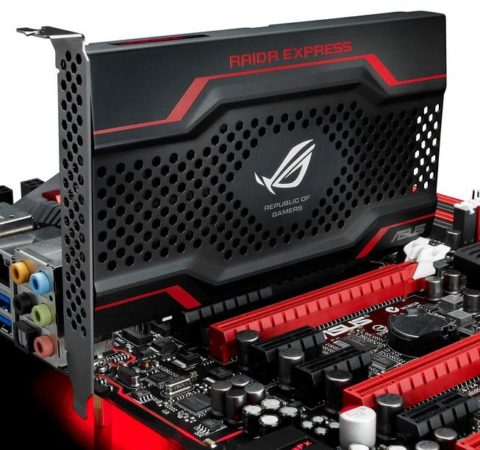Noticias
ASUS RAIDR Express, SSD PCIe ideal para jugones y entusiastas
ASUS ha anunciado lanzamiento de la unidad de estado sólido ASUS RAIDR Express, un modelo en formato PCI-Express de gran capacidad y rendimiento, soporte para BIOS antiguas y las nuevas con UEFI, con un precio de salida en los entornos de los 400 dólares/euros
ASUS ha anunciado lanzamiento de la unidad de estado sólido en formato PCI-Express RAIDR Express, un modelo de gran capacidad y rendimiento, soporte para BIOS antiguas y las nuevas con UEFI, y un precio de salida en los entornos de los 400 dólares/euros.
Ficha técnica
Presentada en el CES, la ASUS RAIDR Express es un dispositivo de almacenamiento novedoso en la firma de Taiwán: una tarjeta PCIe 2.0 x2 con almacenamiento SSD y capacidad de 240 Gbytes.
Un dispositivo responsabilidad de la elitista división de ASUS, ROG ((Republic of Gamers), y que une en un elegante conjunto dos unidades de estado sólido en RAID 0 para máximo rendimiento, establecido en una velocidad de transferencia de datos de 830/810 Mbytes por segundo en modos lectura/escritura y 100.000 IOPS de escritura aleatoria 4K.
La ASUS RAIDR Express usa una de las memorias más avanzadas de la industria: las flash NAND de Toshiba fabricada en 19 nanómetros y entre las más pequeñas y de alta densidad de la industria. Su controlador en este caso doble, es el conocido LSI SandForce SF-2281 utilizado por el 90 por ciento de los fabricantes. Soporta comandos TRIM, SMART y NQC.
Según publicita la firma, la ASUS RAIDR Express sería la primera SSD PCI-e de la industria compatible con BIOS antiguas y con las nuevas UEFI, a las que conocerás por la mayor seguridad que proporciona su arranque seguro y también por los problemas para instalar otro sistema que no sea Windows 8 como Linux.
ASUS solventa el tema ofreciendo un interruptor que puedes ver en la imagen superior para ambos modos, dando soporte a BIOS legacy y a las nuevas interfaces de entrada/salida con UEFI.
En cuanto al precio, está a la venta en Japón desde el anterior fin de semana por 37.800 yenes. Al cambio, unos 400 dólares que se convertirían en 400 euros aunque tendremos que esperar al precio oficial en Europa y América.
No, no es barata, ya que se puede montar una doble SSD de 2,5 mm en RAID con la misma capacidad, rebajando bastante el precio. Eso sí, no alcanzarán el rendimiento de estas PCIe, dedicada a equipos entusiastas y a equipos de alto nivel para juegos PC.
Te dejamos con vídeo y nota de prensa oficial:
With 240GB capacity, sequential 830MB/s read and 810MB/s write speeds, and bundled with tons of features that maintain the high-speed performance and extend the lifespan, RAIDR Express is made for real speed-demons. Boasting the gorgeous ROG red and black design with double-sided metal shielding and an incredible 620,000 hours mean time between failure (MTBF) to ensure quality, RAIDR Express is built to last.
Exclusive design, exclusive flexibility
RAIDR Express isn’t like other SSDs. It’s the world’s first and only PCIe-based SSD with DuoMode BIOS support. With two BIOS chips onboard, RAIDR Express includes a hardware switch that lets users easily alternate between legacy and UEFI modes, ensuring the best compatibility with PCs old and new.
In legacy mode, the RAIDR Express can be used on older motherboards — those with a traditional (non-UEFI) BIOS. By switching to UEFI mode, users can significantly boost PC startup times. With the flexibility of choosing which mode is best, users can enjoy the benefits of both.
Made for real speed demons
With the latest generation dual LSI® SandForce controller, Toshiba-made 19nm 16K-page size multi-level cell (MLC) sync-NAND flash, 100,000 4K read/write input/output operations per second (IOPS) and 830/ 810MB/s sequential read/write speeds, RAIDR Express doesn’t keep users waiting.
As well, RAIDR Express has several other speed-boosting tricks up its sleeve. The bundled RAMDisk utility that allows users to dedicate up to 80% of a computer’s available RAM for use as a high-speed virtual drive that accelerates the loading of favorite applications and games. In ASUS tests, read speeds of over 12,000MB/s were reached.
Better still, RAMDisk extends the life of RAIDR Express by reducing unnecessary write operations. RAMDisk even backs itself up to the main system drive when the PC is shut down and restores itself automatically at power-up, for maximum speed and minimum hassle. The ROG SSD TweakIt tool ups the speed stakes still further by relocating repetitive write activities to the RAMDisk for even faster operation, while keeping RAIDR Express at peak performance for much longer. SSD TweakIt can also be used to apply a preset profile that refines processor settings automatically to achieve additional speed boosts of up to 5%.
RAIDR Express also includes ROG HybriDisk technology super-charges hard disk drive storage. HybriDisk allows RAIDR Express to act as a solid-state cache for high-capacity hard drives up to 4TB, but its PCIe architecture means data transfers smash the 600MB/s SATA limit for traditional PC storage. The included ROG CrystalDiskMark benchmark tool allows users to see for themselves just how fast RAIDR Express can go — and keep on going.
Fast, compatible and built to last
RAIDR Express is fast and offers the widest system compatibility, but it’s also built to last. RAIDR Express is rated at an amazing 620,000 hours’ mean time between failure (MTBF), so users are assured year after year of trouble-free use and strict testing ensures wide system compatibility.
RAIDR Express also has a highly durable design packed with unique ROG innovations designed to extend its lifespan. Tough, double-sided metal shielding provides great heat dissipation and reduces electromagnetic interference (EMI), improving cooling and overall stability.[/expand]
-

 GuíasHace 6 días
GuíasHace 6 díasQué placa base elegir: Guía de compras para Intel y AMD
-

 GuíasHace 2 días
GuíasHace 2 díasGuía para diferenciar generaciones y gamas de tarjetas gráficas
-

 A FondoHace 6 días
A FondoHace 6 díasOfertas Flash del Black Friday 2024 de PcComponentes
-

 A FondoHace 4 días
A FondoHace 4 díasGeForce RTX 5050, especificaciones, rendimiento, equivalencias, fecha de lanzamiento y posible precio



























